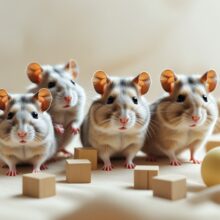Creating a Gerbil-Friendly Home

Creating a Gerbil-Friendly Home: A Comprehensive Guide
Gerbils are delightful and active pets that require a safe, stimulating, and comfortable environment to thrive. Creating a gerbil-friendly home involves thoughtful planning and attention to their specific needs and behaviors. This comprehensive guide will cover the essential elements of a gerbil-friendly home, including housing, bedding, enrichment, diet, safety considerations, and daily care routines.
Housing
The foundation of a gerbil-friendly home is a well-designed and spacious cage that accommodates their natural behaviors and provides a secure and comfortable living space.
Cage Size and Type
- Size: Choose a cage that provides ample space for your gerbils to move around, explore, and engage in natural behaviors. A minimum of 20 gallons is recommended for a pair of gerbils, but larger enclosures are always better.
- Type: Glass aquariums or large wire cages with solid bases are ideal for gerbils. Glass aquariums prevent escapes and provide excellent visibility, while wire cages offer good ventilation. Ensure the wire spacing is narrow enough to prevent your gerbils from squeezing through.
Cage Setup
- Multiple Levels: Incorporate multiple levels and platforms within the cage to maximize vertical space and provide opportunities for climbing and exploration.
- Hideouts and Shelters: Provide several hideouts and shelters made from safe materials like wood, cardboard, or plastic. These offer a sense of security and privacy for your gerbils.
- Secure Lid: Ensure the cage has a secure, well-ventilated lid to prevent escapes and allow for proper airflow.
Bedding
Bedding is a crucial component of a gerbil-friendly home, as it allows them to dig, burrow, and create nests.
Bedding Materials
- Aspen Shavings: Aspen shavings are a popular choice due to their natural texture and safety. They are relatively dust-free and provide a good substrate for burrowing.
- Paper-Based Bedding: Soft and absorbent, paper-based bedding is an excellent option for gerbils with allergies or sensitivities. It is dust-free and non-toxic.
- Hay: Hay can be used as a supplemental bedding material, providing additional nesting material and promoting natural foraging behavior.
Bedding Depth
- Depth: Provide a deep layer of bedding (at least 6 inches) to allow your gerbils to dig and create tunnels. The deeper the bedding, the more opportunities your gerbils will have to engage in natural burrowing behaviors.
Enrichment
Enrichment is essential for keeping your gerbils mentally and physically stimulated. A variety of toys and activities can prevent boredom and promote overall well-being.
Types of Enrichment
- Exercise Wheels: An exercise wheel is essential for physical activity. Choose a wheel with a solid running surface to prevent injuries. The wheel should be large enough for your gerbil to run comfortably without arching its back (at least 8 inches in diameter).
- Tunnels and Hideouts: Gerbils need hiding places and tunnels to feel secure and engage in natural behaviors. Provide multiple hideouts made from safe materials like wood, cardboard, or plastic. Cardboard tubes from paper towel rolls can create DIY tunnels.
- Climbing Structures: Add branches, ladders, and platforms to encourage climbing and exploration. Ensure that any climbing structures are stable and securely attached to prevent accidents.
- Chew Toys: Gerbils have continuously growing teeth and need chew toys to keep their teeth trimmed and healthy. Offer a variety of chew toys made from safe materials like untreated wood, cardboard, and coconut shells. Rotate the toys regularly to keep your gerbils interested and engaged.
- Foraging Opportunities: Encourage natural foraging behavior by scattering food around the cage or using food-dispensing toys. This provides mental stimulation and mimics the natural process of searching for food.
Diet
A balanced diet is crucial for maintaining the health and well-being of your gerbils. Providing the right foods ensures they receive the essential nutrients needed for their growth, vitality, and overall health.
Commercial Gerbil Food
- High-Quality Pellets: High-quality commercial gerbil food or pellets should form the basis of your gerbil’s diet. These foods are specially formulated to provide a balanced mix of protein, fats, and carbohydrates.
Fresh Fruits and Vegetables
- Safe Options: Supplement your gerbil’s diet with fresh fruits and vegetables to provide additional vitamins and minerals. Safe options include apples (without seeds), bananas, berries, carrots, broccoli, kale, and spinach.
- Introduction: Introduce fresh produce gradually to avoid digestive issues. Monitor your gerbil’s response and adjust the quantities as needed.
Protein Sources
- Occasional Treats: Gerbils benefit from occasional protein sources, such as boiled eggs, mealworms, or small pieces of cooked chicken. Protein supports their growth and overall health.
Water
- Fresh Water: Provide fresh, clean water at all times. Use a water bottle with a sipper tube to ensure the water remains uncontaminated. Check the water bottle daily to ensure it is functioning properly and refill it as needed.
Safety Considerations
Safety is paramount when creating a gerbil-friendly home. Ensuring a secure and hazard-free environment helps prevent injuries and health issues.
Cage Safety
- Escape-Proof: Ensure the cage is escape-proof by checking for any gaps or weak spots that your gerbils could squeeze through. Secure the lid and doors to prevent escapes.
- Hazard-Free: Remove any sharp edges, small parts, or toxic materials that could harm your gerbils. Avoid using bedding or toys made from materials that can splinter or break easily.
Supervised Playtime
- Secure Play Area: If you allow your gerbils to play outside their cage, ensure the play area is gerbil-proofed. Remove any hazards such as electrical cords, toxic plants, and small objects that could be ingested.
- Supervision: Always supervise your gerbils during playtime to prevent accidents and ensure their safety.
Daily Care Routines
Establishing daily care routines helps maintain a clean and healthy environment for your gerbils and ensures their well-being.
Spot Cleaning
- Daily Cleaning: Perform daily spot cleaning by removing soiled bedding, uneaten food, and waste. This helps maintain a clean environment and reduces odors.
Feeding and Hydration
- Consistent Feeding: Feed your gerbils at the same time each day to establish a routine. Provide fresh food and water daily, and monitor their intake to ensure they are eating and drinking adequately.
Health Checks
- Regular Monitoring: Perform regular health checks to monitor your gerbil’s well-being. Look for signs of illness, such as changes in behavior, appetite, or appearance. Check their teeth, nails, and fur for any issues.
- Veterinary Care: Schedule regular veterinary check-ups with a vet experienced in small animals. Address any health concerns promptly to ensure your gerbils receive the necessary care.
Conclusion
Creating a gerbil-friendly home involves thoughtful planning and attention to their specific needs and behaviors. By providing a spacious and secure cage, comfortable bedding, engaging enrichment, a balanced diet, and ensuring safety and hygiene, you can create a nurturing environment where your gerbils can thrive. With the right care and attention, your gerbils can enjoy a happy, healthy, and enriching life as cherished members of your family.



